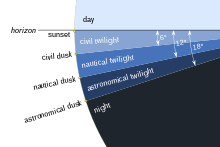Someone jumped on me regarding flying at "blue hour". Seeing the above post got me to do two things - read the definition of "night" (which is different than the phases of twilight and dusk) and the operational guidelines linked above. Blue hour falls within the period known as twilight. Night officially begins when the sun has fallen 18 degrees below the horizon.
Hope this helps.
From Wikipedia:
Sunset or
sundown is the daily disappearance of the
Sun below the
horizon as a result of
Earth's rotation. The Sun will set exactly due west at the equator on the spring and fall
equinoxes, each of which occurs only once a year.

Subcategories of twilight
The time of sunset is defined in
astronomy as the moment when the trailing edge of the Sun's disk disappears below the horizon. Near to the horizon,
atmospheric refractioncauses the ray path of light from the Sun to be distorted to such an extent that geometrically the Sun's disk is already about one diameter below the horizon when a sunset is observed.
Sunset is distinct from
twilight, which has three phases, the first being
civil twilight, which begins once the Sun has disappeared below the horizon, and continues until it descends to 6 degrees below the horizon; the second phase is
nautical twilight, between 6 and 12 degrees below the horizon; and the third is
astronomical twilight, which is the period when the Sun is between 12 and 18 degrees below the horizon.
[1] Dusk is at the very end of astronomical twilight, and is the darkest moment of twilight just before
night.
[2] Night occurs when the Sun reaches 18 degrees below the horizon and no longer illuminates the sky.
Locations north of the
Arctic Circle and south of the
Antarctic Circle experience no sunset or sunrise on at least one day of the year, when the
polar day or the
polar night persists continuously for 24 hours.
Sunset creates unique atmospheric conditions such as the often intense orange and red colors of the Sun and the surrounding sky.




